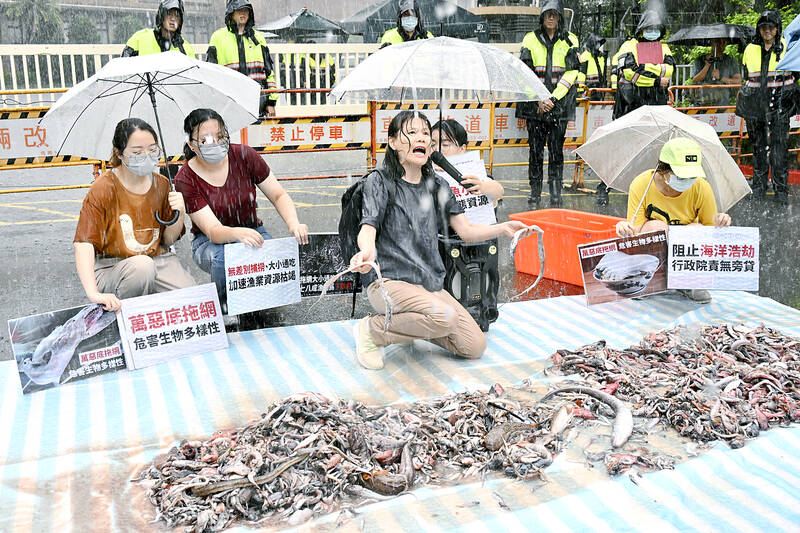Environmental groups yesterday displayed dead fish outside the Executive Yuan in Taipei to protest bottom trawling, which they said results in large amounts of bycatch, or unwanted capture of sea life.
“Bottom trawling is among the most destructive fishing methods, with nets entraining virtually all forms of marine creature, large and small,” the Environment and Animal Society of Taiwan (EAST) said in a news release. “It ravages the seabed, wipes out marine biodiversity, and demolishes habitats for many species of fish, crustaceans, sponges and coral.”
Led by EAST director Chen Yu-min (陳玉敏), the protesters convened a news conference at its office in Taipei, at which they showed videos of the results of bottom trawling.

Photo: George Tsorng, Taipei Times
At 2pm they traveled to the Executive Yuan, where Chen said that public attention had to be focused on bottom trawling after a 600kg goblin shark pregnant with six pups was killed by bottom trawling near Suao Port (蘇澳港) in Yilan County earlier this week.
She also criticized a restaurant in Taipei that served a dish of giant isopod with ramen.
Giant isopods are caught by bottom trawling, she said.
The protesters unveiled the bycatch outside the Council of Agriculture, which has jurisdiction over the Fisheries Agency, they said.
Bottom trawling would wreck the marine environment around Taiwan and deplete fish stocks due to the indiscriminate killing and destruction of marine ecosystems, they said.
The Fisheries Agency must strictly regulate and monitor Taiwanese vessels that use the method and enact measures to phase it out, Chen said.
It should offer benefits and training to promote sustainable fishing, which would help conserve the marine environment and maintain the fishing industry, she said.
“Why not wait until these beltfish grow up, when they would have fetched a higher prices?” she asked, holding up two dead juvenile beltfishes from the pile of bycatch. “Why are we going after everything, large and small, and not thinking about marine regeneration cycles?”
“If this continues, what will happen to our ocean? Will we still have marine creatures?” she asked.
Taiwan has 1,324 ships that bottom trawl, mainly to the northeast and southwest of Taiwan, Fisheries Agency data showed.
More than 200,000 tonnes of catch per year has been recorded using the method, although it has fallen to about 20,000 tonnes per year in the past few years, the data showed.
Bottom trawling accounted for about 13 percent of the nation’s overall near-shore catch in the past few years, the data showed.
Democratic Progressive Party Legislator Lin Shu-fen (林淑芬) asked agency officials to convene a meeting to discuss bottom trawling within two months.
Agency officials promised to assess the situation and present a report in two months, and convene a meeting with lawmakers to discuss ways to improve management of trawling and improve sustainable fishery practices.
The officials said they would look into a three-month ban on bottom trawling each summer, along with allocating funds to buy out bottom-trawler boats, and restrict sales or transfers of such ships.
Another step the agency would consider is nullify the bottom-trawling permit if a transfer takes place, they said.
The Regulations for Prohibited Fishing Area Location of Trawlers and the Relevant Restrictions (拖網漁船禁漁區位置及有關限制事宜) prohibits ships from towing, casting or lifting nets within 5km of the coast and bars ships with a gross displacement of 50 tonnes or more from towing, casting or lifting nets within 12km.

A strong continental cold air mass is to bring pollutants to Taiwan from tomorrow, the Ministry of Environment said today, as it issued an “orange” air quality alert for most of the country. All of Taiwan except for Hualien and Taitung counties is to be under an “orange” air quality alert tomorrow, indicating air quality that is unhealthy for sensitive groups. In China, areas from Shandong to Shanghai have been enveloped in haze since Saturday, the ministry said in a news release. Yesterday, hourly concentrations of PM2.5 in these areas ranged from 65 to 160 micrograms per cubic meter (mg/m³), and pollutants were

Taiwan’s armed forces have established response protocols for a wide range of sudden contingencies, including the “Wan Chun Plan” to protect the head of state, the Ministry of Defense (MND) said today. After US President Donald Trump on Saturday launched a series of airstrikes in Venezuela and kidnapped Venezuelan President Nicolas Maduro, concerns have been raised as to whether China would launch a similar “decapitation strike” on Taiwan. The armed forces regularly coordinate with relevant agencies and practice drills to ensure preparedness for a wide range of scenarios, Vice Minister of National Defense Hsu Szu-chien (徐斯儉) told reporters before a

EVA Airways on Saturday said that it had suspended a pilot and opened an investigation after he allegedly lost his temper and punched the first officer several times as their plane was taxiing before takeoff at Los Angeles International Airport. According to a report published on Thursday by The Reporter, the incident occurred after the flight’s Malaysian first officer tried to warn the Taiwanese pilot, surnamed Wen (文), that he was taxiing faster than the speed limit of 30 knots (55.6kph). After alerting the pilot several times without response, the first officer manually applied the brakes in accordance with standard operating

NOT AN OPENING: Trump’s violation of international law does not affect China’s consideration in attacking Taiwan; Beijing lacks capability, not precedent, an official said Taiwanese officials see the US’ capture of the president of Venezuela as a powerful deterrent to Beijing’s aggression and a timely reminder of the US’ ability to defeat militaries equipped with Chinese-made weapons. The strikes that toppled Venezuelan President Nicolas Maduro signaled to authoritarian leaders, including Chinese President Xi Jinping (習近平), US President Donald Trump’s willingness to use military might for international affairs core to US interests, one senior official in Taipei’s security circle said. That reassured Taiwan, the person said. Taipei has also dismissed the idea that Trump’s apparent violation of international law could embolden Beijing, said the official, who was not